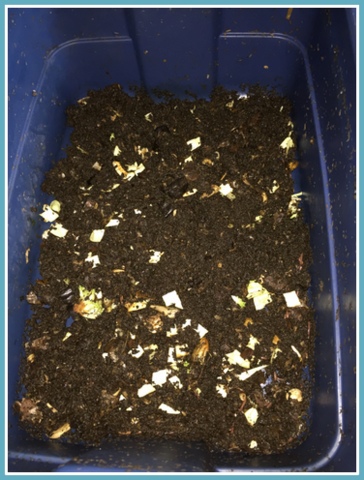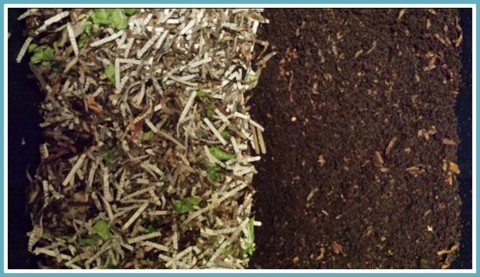
Because we compost and recycle, our household generates little trash. My compost bin is great; my plants love the “garden gold” produced! However, living in New England, we weren’t composting year round. What to do? Compost inside…with vermicomposting! It’s really worthwhile, and simple to do.
My neighbor, Karlyn Sturmer, is a Master Gardener and a Master Composter. She gardens in both containers and raised beds, and also focuses on native plantings and habitats for wildlife. Karlyn uses vermicomposting to fertilize both her indoor and outdoor plants. When her worm bin recently became too full with working worms, she offered to help me get a worm bin started, sharing worms from her bin. I’ve long wanted to create a “worm ranch”, after reading the book Worms Eat My Garbage by Mary Appelhof, while earning the “Gaining Ground” Farmgirl Sisterhood Badge.

To start a vermicomposter, you’ll need a 22” x 15.5”, solid (not translucent or transparent), lidded plastic storage bin (like those made by Rubbermaid). It should be clean and dry to start (remember, living creatures will call it home)!
My bin’s deeper than what I really needed, but it’s always good to use what’s on hand. Karlyn showed me her completed bin. The compost inside was very wet, indicating there were now too many worms.


The inside of the Karlyn’s bin was a bit too wet – time to move some worms!
Karlyn originally started with a ¼ – ½ pound of Red Wigglers. Red Wigglers are a surface crawler type of worm, as opposed to the earthworms outside that are “European crawlers”. There’s actually no true native earthworm – they were re-introduced (after disappearing during the Ice Age) to America by the colonists.
To start, air holes are drilled in the bottom of the bin, and along the rim of the box. Use a small drill bit – you don’t want your little residents to climb out of the box through the ventilation holes. We used a 3/16” drill bit size. The holes help prevent the inside from becoming too moist and thus moldy. Make sure to get all the plastic bits from the drilled holes out of the inside of the bin.


Next, we cut the recessed square of plastic from the top middle portion of the lid, closing it back up with screening using strong tape. Karlyn shared some pet screening, which she prefers because it’s dark. Worms dislike light, and will move downward if light enters the box. Wire screening can be used too, if you have it on hand.



Karlyn’s kitty kept watch while we worked…
With that done, it was time to set up the inside. Worms need food, bedding, water, and oxygen. For bedding we lined the box with shredded newspaper, using only black and white, soy-based-ink newsprint. We dampened it with water, making it moist like a wrung-out sponge. If you have city water, Karlyn recommends letting it sit overnight before using it in the bin. The worms need plenty of bedding, so Karlyn keeps a bag of shredded newspaper on hand nearby her bin.

A handful of “clean” dirt was added next. Karlyn screened her topsoil pile to remove any unwanted debris. Soil helps keep the worms’ guts clean, and introduces necessary microorganisms.


Next we added food: a bit of shredded lettuce, some turnip pieces, a little fruit, and coffee grounds, a worm “favorite”. I add a bit of coffee grounds to my new bin about once a week, when I feed them. The rules for “feeding” your worms are the same as for any compost bin: no meat, dairy, cooked foods, oils or fats. Also, no onions, garlic or citrus – they’re too acidic for worms.

When adding food to an established worm farm, mix it in so the worms do not have to come to the surface to eat.
With my new bin ready for residents, the next step was sorting through the rich, moist compost generated by Karlyn’s worms. We created a pile of undigested food, one of compost, and one of worms and eggs. The worms will double in about 3 – 4 months, depending on factors like how much food and moisture there is. Picking out those little red wigglers was enjoyable…very calming. Until she’s ready to use it in her plants and garden, Karlyn keeps the finished compost that’s created in a clean recyclable-plastic, lidded jar (like the ones pretzels come in) with a few air holes drilled in it, in case she misses any worms in sorting.

Sorting the worms…

The worms multiply. Here is a baby worm!

Worm eggs are lemon-shaped and tiny. 3 – 4 babies will hatch from this egg.

Worms (top), finished compost (right), and undigested food that will go to the outdoor composter (left).
Karlyn advises that when starting a new vermicomposting bin, use a reliable source for red wiggler (Eisenia foetida) worms. Be wary; you could unwittingly end up with the invasive form of earthworm (Amynthas agrestis) that’s becoming a real issue. A good online source for desirable red wigglers is http://www.wormladies.com/.

Red wigglers ready to move to a new bin!
It’s fascinating how disposable items like food scraps and newspaper create such a valuable resource. Karlyn says if you open your bin and notice worms climbing up the sides in numbers, it’s an indication something isn’t in balance (too wet, too dry, more food is needed).

When the compost is almost ready, Karlyn moves it to one side of the bin, and starts with fresh bedding on the other. What an amazing transformation! Photo courtesy of Karlyn Sturmer.
I keep my “worm ranch” in my basement, where it’s cool and dark. Several weeks later, my worms are happy and thriving. Vermicomposting takes little effort, cuts down on household garbage, and creates rich, usable compost! Thanks, Karlyn, for getting me started!
Until Next Time… Farmgirl Hugs, Nicole











I wish I knew more about composting….I have two outside compost containers and I don’t know how well its working until spring. This past spring I found a layer of dry looking tomatoes but not much as far as fertilized dirt. I fill the containers , water a bit’ and leave the lids unlocked and open when its too hot. And was quite faithful about putting scraps in the bin. I see worms but nothing like your mini compost . I prefer to feed my worms the scraps and sometime I get a bountiful supply of worms and spread them around to other sections of my garden. I prefer to not add anything foreign to my garden.because when I have, I found I would get other forms of pestilence.
Every change you make to your soil affects it….its what I have learned over my lifetime of gardening-farming. When I brought some mulch in, I brought new pest and new weeds that have caused he nothing but troubles….good luck on your mini compost!
Hi Susana, you didn’t say what kind of containers your compost bins are. All compost needs some air circulating through it. Also, you want to balance your brown (dry, carbon-containing material) with your green (moist, nitrogen-containing material, and “turn” your outdoor compost from time to time. Try “chopping up” some of what you put in it, too, as large pieces might not break down as fast as smaller pieces. Having my worm bin inside does not keep me from composting outside, it is a compliment to it, and I definitely use the compost it creates! Good luck! Thanks for “stopping by”…Farmgirl Hugs, Nicole
Interesting – simply interesting!!
Hi Joan, So glad you enjoyed the post. I’ve had my bin several weeks now, and am surprised at how little effort it really takes compared to the reward. Let me know if you start a bin. Farmgirl Hugs, Nicole
What an interesting article! We used to raise fish worms in the 1960’s but they finally died out, or got eaten by fish. I don’t fish, but I’ve always loved worms, just to watch what they do with what we don’t want. They are the ultimate recyclers.
A dear friend, the late photographer Al Clayton, and his wife, Mary Ann, a food designer, produced a book called Dreadful Delicacies; you can guess the subject matter. I can still see him leaning against our kitchen counter saying in his very strong southern accent, “Now, you can eat a grubworm, but don’t you EVAH eat a red wriiiaahglah! That taste just haaayngs on your tongue for weeks!” I’ll just be happy to watch them. Thanks for the informative blog.
Hi Wayve, Love the comment! I agree with you…I’d rather watch the worms than dine on one, but I bet that book is really interesting reading! Thanks for putting a smile on my face today. Hope you drop by the blog again…Nicole
This is a really good tutorial about raising worm compost! The pictures are so informative and goes along with the well written commentary.
When I first heard about this book I was curious because the lady who wrote “Worms Eat My Garbage” was from my home town. It was so cool because as you read in the book, she taught students to use shoe boxes and the garbage the students generated to teach them about this. I’m so glad that book is still around.
The bins I use are commercial and catch the “liquid gold” ( worm tea : ) in the bottom of it which is a really good by product, too.
I did try a container with the holes in the bottom and didn’t realize there would be liquid. It made a real mess on the basement floor and my hubby (understandably) was not real keen on my continuing to use THAT kind of bin. But I think you could just put some kind of catch basin under the kind of container you use shoe box or storage bin and it would do the same thing.
Hi Pat, Thanks for the comment! I love the book, Worms Eat My Garbage! I think it is still the best one out there. I found it in my local library. As for the worms, yes, it gets moist on the bottom. I have mine raised up a bit on two boards, with newspaper underneath. You could put use another lid from a bin as a tray, too. I will ask Karlyn what she does to combat any liquid (and perhaps collect it for use) and get back to you here. Farmgirl Hugs, Nicole
Yes, I’ll like to hear what Karlyn suggests. Always something more to learn!
I’m glad you included the website link to “wormladies”! I had to smile when I read the website address. When my grand kids were little they used to love to come and see the worms. Even the girls and not one of them ever said, “Eeeeeeeeuuuu”. lol
Hi Pat, Here is what Karlyn suggests:
‘To catch any of the liquid that drains from your bin, you can use a second tote cover, a second stackable tote or a plastic tray. If necessary, create spacers with lumber scraps or gravel so the holes don’t sit directly on the tray. The runoff is a great natural fertilizer and, as with many fertilizers, it requires some dilution, perhaps 10:1, water to “tea”.’ ~ Karlyn
Hi Nicole,
Thanks for sending that answer about the “worm tea” from her. I never knew that it needed to be diluted so that information is a treasure to have.
Love being a Farmgirl at heart! I married such a city boy. lol But my heart will always be in the country.
Smiles,
You’re very welcome, Pat! Thanks so much for reading the blog. One of the things I love about MaryJanesFarm is the idea that we can be ‘farmgirls’ no matter where we reside! Farmgirl Hugs, Nicole
I so enjoyed reading your blog about “worm farming.” That’s what my second grade class and I call it. I’ve sponsored a worm farm in my classroom for the last 5 years. Every year we explore our worms, feed them healthy snack leftovers, tear up newspapers and then harvest their “black gold” for our school garden in the spring. The children take care of their squirmy pets and love it!!!
Hi Andrea, What a great class project! I love it! I bet the kids want to eat healthy snacks just to feed something to the worms, too. Thanks for reading and commenting. Farmgirl Hugs, Nicole
Nicole,
This is AWESOME!!!! I cannot wait to do this. Going to include my grand-girls on this project. They love worms, so they will really love this! Super post and so informative!
Dori
Hi Dori, Thanks! Isn’t this a great thing to do with kids? If I had known how easy it was, I would have done it ages ago. Karlyn was so awesome to help me set this up! When my worms get overpopulated, I will pay it forward and help someone else set up a bin. Glad you liked the post. Farmgirl Hugs, Nicole
I am still in the learning phase of earth worming and keep finding worms in the ‘worm wee’ catcher part of my bins. Really not sure why. Is there not enough food, is it not warm enough, is it too warm, is there too much or too little light? Please help, can’t figure it out.
Hi Alison, if worms are not staying where they belong it could be that there is not enough food or it is too dry or too wet. It should feel like the moisture of a wrung out kitchen sponge. Let me know if changing that helps. Good luck! Farmgirl Hugs, Nicole
I need some advice.
I have two bins. One is a Worm Farm 360, square bin with 4 tiers. The other is a Can O Worms, 3 tiers.
The 360 has an excess of PotWorms. I’ve tried adding lime, egg shells, more paper and aerating. The red worms just don’t thrive. I feed them the same food as the I feed the Can, just smaller quantities. I did buy new worms, and they do appear to be living so far. Should I keep adding more lime? Try to remove the potworms?
The Can works great but recently I was checking the tiers and found literally hundreds of worms congregated in the very bottom, where there is no food, no nesting material, mainly just liquid. I moved them to the top tier. Why do they go to the bottom? Should I be checking this more?
Hi Sandra, I will check in with one of my worm “experts”, and see if they have anything different to say, but in my experience, when something like that happens, there is unbalance. I would say remove the worms (something I do every once in a awhile), and add more dry material if you see excess liquid. If they climb to the top, that usually means you have too much dry, but in this case, it seems the balance is going the other way, and you need more “dry” material. Let me see if I can find anything else out for you. Thanks for reading! By the way…you will probably find next week’s blog very interesting…Farmgirl Hugs, Nicole
Actually, I think I figured out that it was too dry. We run a dehumidifier in the room. I started adding water and things have improved. I’ve also started PH testing the soil. I added lots of lime during the time I thought it was too acidic, based on the little white worms. It turns out both bins are highly basic. Too much lime added. I’ve stopped adding lime and started adding more acidic things.
Hi Sandra, sounds good. Keep in mind, that with the worm bins, the worms will “tell” you if they are not happy by how they act – “clumping”, climbing out…that sort of thing. Usually means something is unbalanced, and in your case it was your dryness. Good luck! Farmgirl Hugs, Nicole